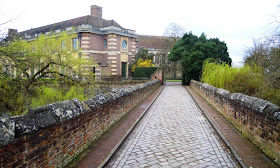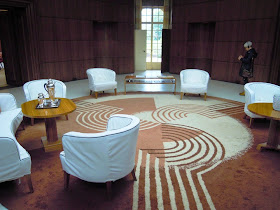We live less than five miles from Eltham Palace and in the past Sue and I have taken part in award ceremonies that were held in the Palace's Great Hall. For some years English Heritage has been restoring the main building and Palace's gardens, and recently these were reopened to the public. As we are members of English Heritage, the weather was not too bad, and it was Good Friday, we decided to visit the Palace.
There has been a palace in Eltham since before 1305, when Edward II gave it to the then Bishop of Durham, Anthony Bek. The palace was then used as a royal residence from the 14th to the 16th century. It is believed that Eltham Palace was Henry IV's favourite residence, and it is known that Henry VIII was brought up there. Until Greenwich Palace was rebuilt, the Tudor monarchs usually celebrated Christmas at Eltham Palace, but gradually it fell out of use and only served as a hunting lodge.
By the end of the Civil War the Palace was described as being ‘a miserable ruin’ and it was given to John Shaw by Charles II. By this time all that remained was Edward IV's Great Hall (which had been built in the 1470s), the former buttery, the bridge over the moat, and some of the walls. It remained in the Shaw family’s hands and in this condition until the late nineteenth century.
In the 1933 the lease of the site was acquired by the Stephen Courtauld and his wife Virginia, and they set about building a new Art Deco-style house next to the Great Hall. The latter – which has the third largest hammer beam roof in England – was restored.
The Courtauld family lived in the Palace until 1944, and in March 1945 they passed the lease on to the Royal Army Education Corps. Because it was an army base, the site was bombed by the IRA in May 1990, and seven people were injured. The Corps used the Palace as their headquarters until 1992, and in 1995 its management and upkeep was taken over by English Heritage.
After parking our car in the nearby English Heritage car park, we walked along the path that took us to the entrance to the bridge across the Palace's moat.
The bridge gave us an excellent view of the moat and the gardens that had been developed in the dry part of the ditch.
It also gave us the opportunity to see some of the older stone decorations that form part of the inner wall of the moat's ditch.
Once across the bridge we entered the main courtyard that gives access to both the old and newer parts of the Palace.
The entrance hall of the Art Decor building is stunning, and it is no surprise that it is used frequently as a set for films and TV programmes.
The walls of the entrance hall are decorated with marquetry panels that depict medieval scenes.
Off the entrance hall is the dining room, which is a stunning example of the Art Decor style.
Even the staircase that goes up to the first floor of the building is a marvel of the Art Decor style.
Once we reached the first floor we were directed into the viewing room, where a film about the history of Eltham Palace is regularly shown throughout the day.
The main corridor on the first floor is rather understated when compared with the viewing room ...
... but the opulent Art Decor style is – if anything – rather overstated in Virginia Courtauld's bedroom ...
... and bathroom.
In comparison, Stephen Courtauld's bedroom is much more austere ...
... but not quite as austere as the bedrooms that were used by Virginia Courtauld's nephews.
The corridor then led us to the minstrel's gallery, which gave us a wonderful of the restored Great Hall ...
... and its hammer beam roof.
We then went down to the ground floor by a rather less ornate staircase, and this led us to the library ...
... and to Stephen Courtauld's study.
Over the fireplace in the study is a statue ...
... which is entitled The Sentry. It was made by Charles Sargeant Jagger, and is a smaller version of a statue that forms part of a Manchester war memorial. (Charles Sargeant Jagger, was – like Stephen Courtauld – a member of the Artists' Rifles during the First World War.)
We then passed through the Great Hall ...
... and out into the Palace's garden.
From the garden terrace we were able to see the rock garden and fountain that the Courtaulds added to the moat ditch.
We then carried walking on around the outside of the Palace until we reached the bridge ...
... which we crossed before returning to collect our car from the car park.
There has been a palace in Eltham since before 1305, when Edward II gave it to the then Bishop of Durham, Anthony Bek. The palace was then used as a royal residence from the 14th to the 16th century. It is believed that Eltham Palace was Henry IV's favourite residence, and it is known that Henry VIII was brought up there. Until Greenwich Palace was rebuilt, the Tudor monarchs usually celebrated Christmas at Eltham Palace, but gradually it fell out of use and only served as a hunting lodge.
By the end of the Civil War the Palace was described as being ‘a miserable ruin’ and it was given to John Shaw by Charles II. By this time all that remained was Edward IV's Great Hall (which had been built in the 1470s), the former buttery, the bridge over the moat, and some of the walls. It remained in the Shaw family’s hands and in this condition until the late nineteenth century.
In the 1933 the lease of the site was acquired by the Stephen Courtauld and his wife Virginia, and they set about building a new Art Deco-style house next to the Great Hall. The latter – which has the third largest hammer beam roof in England – was restored.
The Courtauld family lived in the Palace until 1944, and in March 1945 they passed the lease on to the Royal Army Education Corps. Because it was an army base, the site was bombed by the IRA in May 1990, and seven people were injured. The Corps used the Palace as their headquarters until 1992, and in 1995 its management and upkeep was taken over by English Heritage.
After parking our car in the nearby English Heritage car park, we walked along the path that took us to the entrance to the bridge across the Palace's moat.
The bridge gave us an excellent view of the moat and the gardens that had been developed in the dry part of the ditch.
It also gave us the opportunity to see some of the older stone decorations that form part of the inner wall of the moat's ditch.
Once across the bridge we entered the main courtyard that gives access to both the old and newer parts of the Palace.
The entrance hall of the Art Decor building is stunning, and it is no surprise that it is used frequently as a set for films and TV programmes.
The walls of the entrance hall are decorated with marquetry panels that depict medieval scenes.
Off the entrance hall is the dining room, which is a stunning example of the Art Decor style.
Even the staircase that goes up to the first floor of the building is a marvel of the Art Decor style.
Once we reached the first floor we were directed into the viewing room, where a film about the history of Eltham Palace is regularly shown throughout the day.
The main corridor on the first floor is rather understated when compared with the viewing room ...
... but the opulent Art Decor style is – if anything – rather overstated in Virginia Courtauld's bedroom ...
... and bathroom.
In comparison, Stephen Courtauld's bedroom is much more austere ...
... but not quite as austere as the bedrooms that were used by Virginia Courtauld's nephews.
The corridor then led us to the minstrel's gallery, which gave us a wonderful of the restored Great Hall ...
... and its hammer beam roof.
We then went down to the ground floor by a rather less ornate staircase, and this led us to the library ...
... and to Stephen Courtauld's study.
Over the fireplace in the study is a statue ...
... which is entitled The Sentry. It was made by Charles Sargeant Jagger, and is a smaller version of a statue that forms part of a Manchester war memorial. (Charles Sargeant Jagger, was – like Stephen Courtauld – a member of the Artists' Rifles during the First World War.)
We then passed through the Great Hall ...
... and out into the Palace's garden.
From the garden terrace we were able to see the rock garden and fountain that the Courtaulds added to the moat ditch.
We then carried walking on around the outside of the Palace until we reached the bridge ...
... which we crossed before returning to collect our car from the car park.





































What a beautiful Manor House. I really want something like that in 6mm for my ECW project.
ReplyDeletePaul O'G,
ReplyDeleteIf you ever get the chance, pay the Palace a visit.
All the best,
Bob
Suzanne tells me that she was interviewed here for her post in Germany, back when the British Forces Education Service occupied the place.
ReplyDeleteRegards, Chris.
Chris Kemp,
ReplyDeleteI was working in my (then) office just about half a mile from the Palace when the IRA bomb went off. I felt the pressure wave and the windows rattled just before I heard the deep boom that followed. I knew right away what it was, and by the time I reached the window the smoke and dust cloud was already rising above the building.
All the best,
Bob